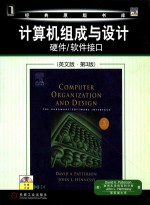图书介绍
计算机组成与设计 硬件/软件接口 第3版pdf电子书版本下载

- (美)帕特森(Patterson,D.A.)等著 著
- 出版社: 北京:机械工业出版社
- ISBN:7111193393
- 出版时间:2006
- 标注页数:643页
- 文件大小:81MB
- 文件页数:665页
- 主题词:计算机体系结构-英文;微型计算机-接口设备-英文
PDF下载
下载说明
计算机组成与设计 硬件/软件接口 第3版PDF格式电子书版下载
下载的文件为RAR压缩包。需要使用解压软件进行解压得到PDF格式图书。建议使用BT下载工具Free Download Manager进行下载,简称FDM(免费,没有广告,支持多平台)。本站资源全部打包为BT种子。所以需要使用专业的BT下载软件进行下载。如 BitComet qBittorrent uTorrent等BT下载工具。迅雷目前由于本站不是热门资源。不推荐使用!后期资源热门了。安装了迅雷也可以迅雷进行下载!
(文件页数 要大于 标注页数,上中下等多册电子书除外)
注意:本站所有压缩包均有解压码: 点击下载压缩包解压工具
图书目录
1 Computer Abstractions and Technology 2
1.1 Introduction 3
1.2 Below Your Program 11
1.3 Under the Covers 15
1.4 Real Stuff:Manufacturing Pentium 4 Chips 28
1.5 Fallacies and Pitfalls 33
1.6 Concluding Remarks 35
1.7 Historical Perspective and Further Reading 36
1.8 Exercises 36
COMPUTERS IN THE REAL WORLD Information Technology for the 4 Billion without IT 44
2 Instructions:Language of the Computer 46
2.1 Introduction 48
2.2 Operations of the Computer Hardware 49
2.3 Operands of the Computer Hardware 52
2.4 Representing Instructions in the Computer 60
2.5 Logical Operations 68
2.6 Instructions for Making Decisions 72
2.7 Supporting Procedures in Computer Hardware 79
2.8 Communicating with People 90
2.9 MIPS Addressing for 32-Bit Immediates and Addresses 95
2.10 Translating and Starting a Program 106
2.11 How Compilers Optimize 116
2.12 How Compilers Work:An Introduction 121
2.13 A C Sort Example to Put It All Together 121
2.14 Implementing an Object-Oriented Language 130
2.15 Arrays versus Pointers 130
2.16 Real Stuff:IA-32 Instructions 134
2.17 Fallacies and Pitfalls 143
2.18 Concluding Remarks 145
2.19 Historical Perspective and Further Reading 147
2.20 Exercises 147
COMPUTERS IN THE REAL WORLD Helping Save Our Environment with Data 156
3 Arithmetic for Computers 158
3.1 Introduction 160
3.2 Signed and Unsigned Numbers 160
3.3 Addition and Subtraction 170
3.4 Multiplication 176
3.5 Division 183
3.6 Floating Point 189
3.7 Real Stuff:Floating Point in the IA-32 217
3.8 Fallacies and Pitfalls 220
3.9 Concluding Remarks 225
3.10 Historical Perspective and Further Reading 229
3.11 Exercises 229
COMPUTERS IN THE REAL WORLD Reconstructing the Ancient World 236
4 Assessing and Understanding Performance 238
4.1 Introduction 240
4.2 CPU Performance and Its Factors 246
4.3 Evaluating Performance 254
4.4 Real Stuff:Two SPEC Benchmarks and the Performance of Recent Intel Processors 259
4.5 Fallacies and Pitfalls 266
4.6 Concluding Remarks 270
4.7 Historical Perspective and Further Reading 272
4.8 Exercises 272
COMPUTERS IN THE REAL WORLD Moving People Faster and More Safely 280
5 The Processor:Datapath and Control 282
5.1 Introduction 284
5.2 Logic Design Conventions 289
5.3 Building a Datapath 292
5.4 A Simple Implementation Scheme 300
5.5 A Multicycle Implementation 318
5.6 Exceptions 340
5.7 Microprogramming:Simplifying Control Design 346
5.8 An Introduction to Digital Design Using a Hardware Design Language 346
5.9 Real Stuff:The Organization of Recent Pentium Implementations 347
5.10 Fallacies and Pitfalls 350
5.11 Concluding Remarks 352
5.12 Historical Perspective and Further Reading 353
5.13 Exercises 354
COMPUTERS IN THE REAL WORLD Empowering the Disabled 366
6 Enhancing Performance with Pipelining 368
6.1 An Overview of Pipelining 370
6.2 A Pipelined Datapath 384
6.3 Pipelined Control 399
6.4 Data Hazards and Forwarding 402
6.5 Data Hazards and Stalls 413
6.6 Branch Hazards 416
6.7 Using a Hardware Description Language to Describe and Model a Pipeline 426
6.8 Exceptions 427
6.9 Advanced Pipelining:Extracting More Performance 432
6.10 Real Stuff:The Pentium 4 Pipeline 448
6.11 Fallacies and Pitfalls 451
6.12 Concluding Remarks 452
6.13 Historical Perspective and Further Reading 454
6.14 Exercises 454
COMPUTERS IN THE REAL WORLD Mass Communication without Gatekeepers 464
7 Large and Fast:Exploiting Memory Hierarchy 466
7.1 Introduction 468
7.2 The Basics of Caches 473
7.3 Measuring and Improving Cache Performance 492
7.4 Virtual Memory 511
7.5 A Common Framework for Memory Hierarchies 538
7.6 Real Stuff:The Pentium P4 and the AMD Opteron Memory Hierarchies 546
7.7 Fallacies and Pitfalls 550
7.8 Concluding Remarks 552
7.9 Historical Perspective and Further Reading 555
7.10 Exercises 555
COMPUTERS IN THE REAL WORLD Saving the World's Art Treasures 562
8 Storage,Networks,and Other Peripherals 564
8.1 Introduction 566
8.2 Disk Storage and Dependability 569
8.3 Networks 580
8.4 Buses and Other Connections between Processors,Memory,and I/O Devices 581
8.5 Interfacing I/O Devices to the Processor,Memory,and Operating System 588
8.6 I/O Performance Measures:Examples from Disk and File Systems 597
8.7 Designing an I/O System 600
8.8 Real Stuff:A Digital Camera 603
8.9 Fallacies and Pitfalls 606
8.10 Concluding Remarks 609
8.11 Historical Perspective and Further Reading 611
8.12 Exercises 611
COMPUTERS IN THE REAL WORLD Saving Lives through Better Diagnosis 622